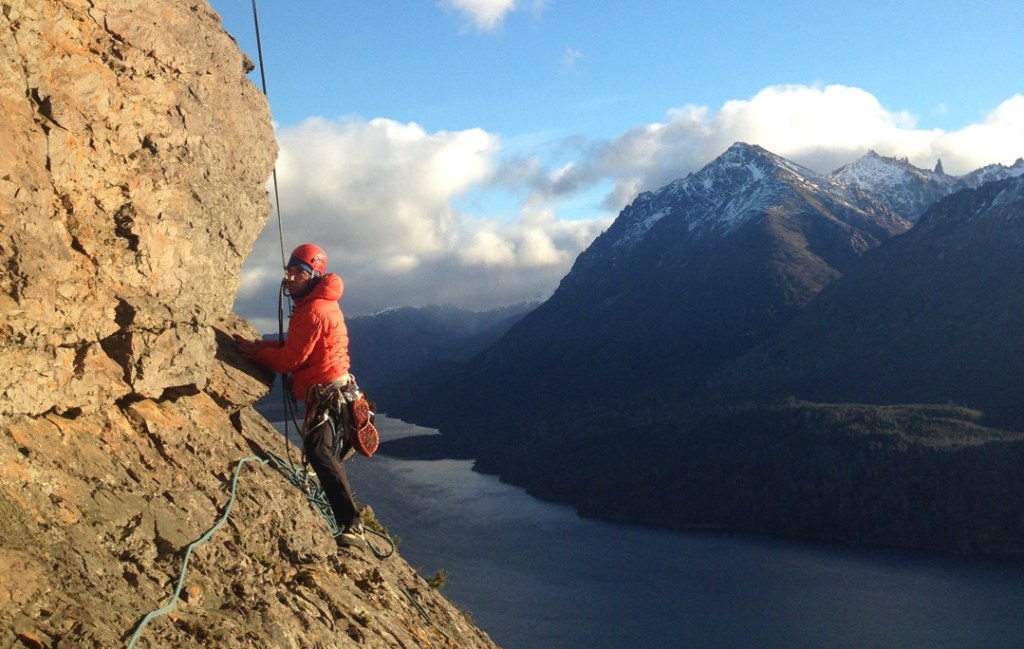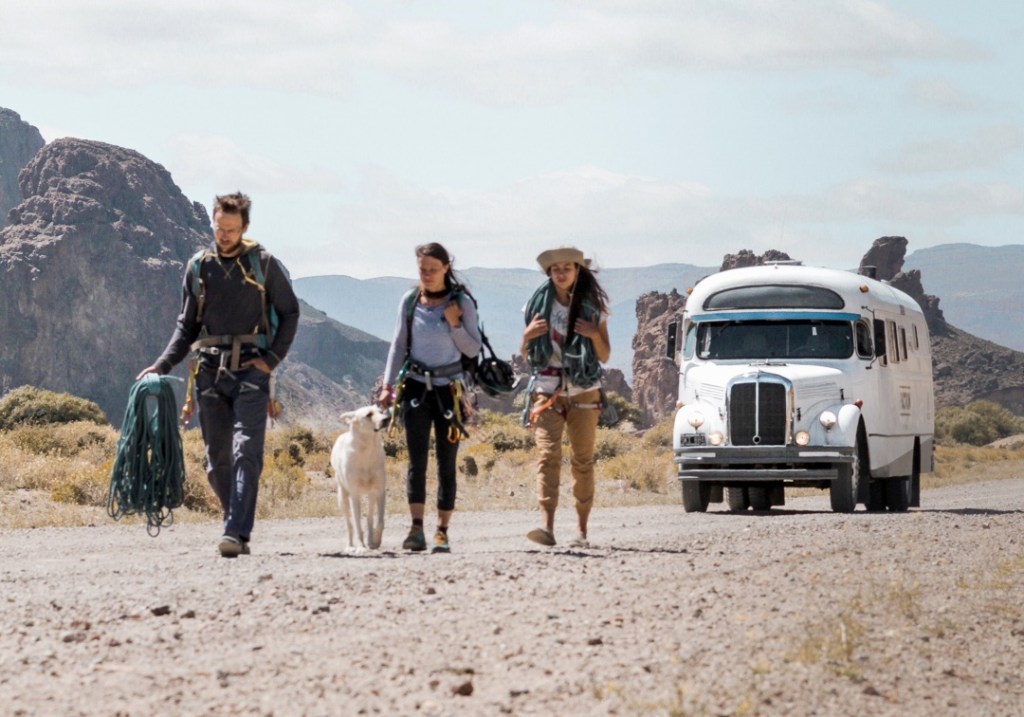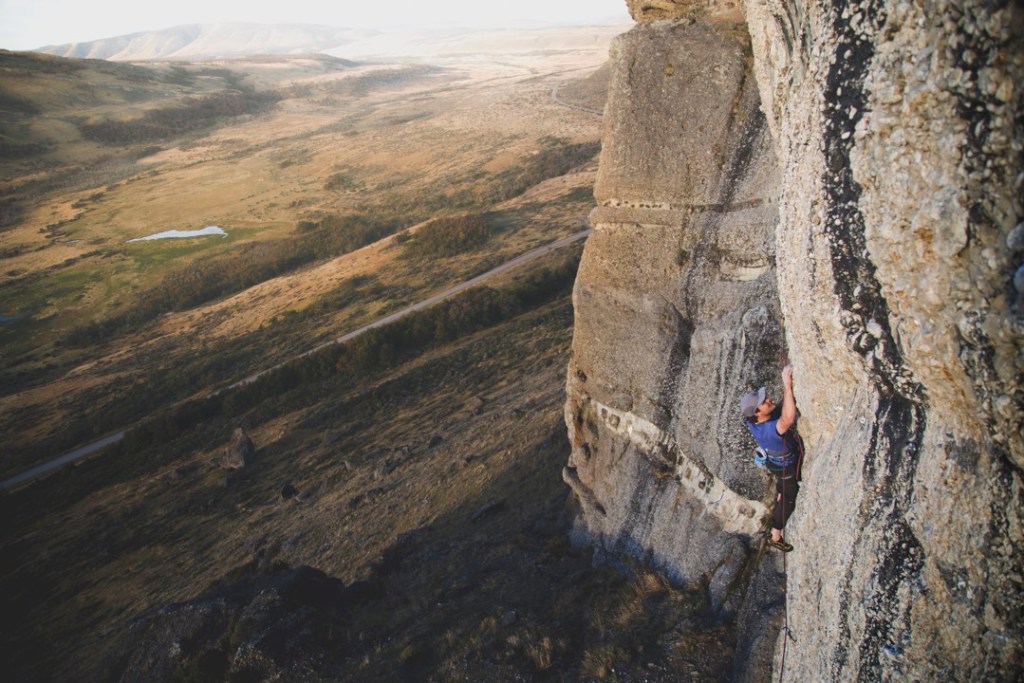Patagonia lures adventurous souls, but with iconic images of the Fitz Roy massif or the peaks of Torres del Paine in mind, beginner and intermediate climbers may feel that climbing in Patagonia is out of reach for them. The good news is, it’s not. While the Fitz Roy massif and southern Chile’s famous towers themselves might not be beginner-friendly, Patagonia still boasts something for everyone. Here are six of Patagonia’s countless destinations perfect for a climbing trip, even if you’re not an expert alpinist.

Photo credit: Dylan Harris
Cerro Ventana Sur, Argentina
Many of Patagonia’s climbing areas offer sweeping views of mountains, lakes and rivers, and Cerro Ventana Sur is no exception. Just south of Bariloche along Ruta 40 and Lago Gutierrez, Ventana Sur is particularly good for beginner and intermediate climbing. There is some loose rock in this area, so be aware at all times, even while hiking, and always wear a helmet.
How do I get there?
You can drive or hitchhike to Ventana Sur. For a few pesos, you can also take a remis, similar to a taxi, from Bariloche to Ventana Sur and back. When you are on Ruta 40 and west of Cerro Ventana, essentially between the mountain and Lago Gutierrez, look for the stone retaining wall along the road. From there, look for footprints and cairns marking the climbers’ trail. Once you can see the rock face, about five minutes up, use photos for reference and continue hiking toward the base, about 20 to 30 minutes of steep hiking.
Which routes are good for beginner and intermediate climbers?
Many newly bolted routes on Ventana Sur are great for beginners, ranging in grade from 4th class to low 5th class with a few that have crux moves of 5.10a/b. For those new to multi-pitch climbing, Dylan Harris, who’s been climbing and putting up routes in and around Bariloche the past few years, recommends starting with the Sirtaki route. From there, the best overall routes for 5.10a leaders are Ruach de Jonah, Lo Spirito dei Montani, Gal Mebulbal and Brambillandia.
Recommended campgrounds?
About 10 minutes or less by car from Ventana Sur, there are campgrounds in Los Coihues on the north side of Lago Gutierrez.

Photo credit: Manu Fombeurre
Villa Llanquín, Argentina
North of the outdoor-recreation hub of Bariloche, where the mountains roll into the steppe, Villa Llanquín lies along the Río Limay. Unlike nearby mountain towns, Villa Llanquín has a more desertlike climate. A volcanic, reddish, good quality rock makes up its climbing areas—similar to parts of the southwestern U.S.
How do I get there?
From Bariloche, Villa Llanquín is around a 45-minute drive, just off Ruta 237. You can park at a lot between the road and the river and walk across the pedestrian bridge to the climbing areas—or you can take your car for free across the Río Limay on the raft, a one-car ferry of sorts, that runs parallel to the bridge. Do your research, and know where you’re going before you head out, as most of the “trails” are not marked. In Bariloche, you can get more info from Club Andino Bariloche, Entropía Escalada or La Luna Muro.
Which area is good for beginner and intermediate climbers?
With bolted routes of varying grades, the La Cosa area is great for beginner and intermediate climbers, as well as advanced climbers. The area has a few low-5th-class multi-pitch routes. More detailed information on routes can be found via Bariloche Vertical.
Recommended campgrounds?
The Don Jacinto campground sits along the river, where you’ll have a beautiful, roughly 30-minute hike to get to and from La Cosa.

Photo credit: Elena Guerra
Cochamó Valley, Chile
Near Puerto Montt in northern Patagonia, Cochamó Valley has been dubbed the “Chilean Yosemite.” The valley’s towering granite walls plunge into a valley of thick, wild green.
How do I get there?
Cochamó Valley is about a four-hour hike from the pueblo of the same name. While you can take a car or public transit to the trailhead, the valley is not accessible to vehicles, which in many ways makes it that much more appealing. The trail opens at 8am and closes at 3pm. Before hiking in, you’ll want to register at the trailhead.
Which routes are good for intermediate climbers?
Please note Cochamó Valley is better if you already have a little experience in both sport and traditional climbing. Camp Farm and La Zebra are good routes to start. Both are relatively close to the campground and have good protection. E.Z. Does It, a longer multi-pitch route from which you reach a beautiful summit, is also of note for intermediate climbers. The valley is very remote, so practice more caution than normal with safety and remember your role in protecting Cochamó Valley’s unspoiled wilderness.
Recommended campgrounds?
In Cochamó Valley, the La Junta campground will keep you within distance of numerous climbs. During the summer season, you’ll want to reserve your campsite in advance. La Junta has bathrooms, showers and running water. More info and prices can be found at https://cochamo.com/camping.

Photo credit: Manu Fombeurre
Piedra Parada, Argentina
Piedra Parada is likely different from what you picture when you think of Patagonia—similar to Villa Llanquín and Smith Rock in Oregon, it’s a more desertlike climate and landscape. And it’s an incredible place to go climbing and camping for an extended period of time. Piedra Parada is composed of volcanic tuff and offers a plethora of opportunities for climbers at all levels and in all disciplines. But take note: Piedra Parada is a provincial protected area, and dogs and other pets are not allowed.
How do I get there?
Piedra Parada is accessible by car or bus. If you are heading south from Bariloche or north from El Chaltén, speak with the locals in either location to determine the best way to reach the pueblo of Gualjaina and then Piedra Parada. From Bariloche, it’s about five to seven hours driving. From the Piedra Parada rock feature and nearby campground, it’s about a 10-minute walk to enter the canyon. The canyon itself is a few kilometers long and has side canyons that branch off of it, all of which offers endless opportunities for climbing.
Which areas or routes are good for beginner and intermediate climbers?
The area boasts more than 270 routes. The best areas for beginner and intermediate climbers are El Alero, El Gruyere, Ortigas, El Circo, Anfiteatro, Jardín del Edén, Cañadón de las Sombras and La Calavera.
Recommended campgrounds?
The Establecimiento La Buitrera campground, around 600 meters from the start of the canyon, is an ideal place to camp. Due to Piedra Parada’s remote location, you should also pack a good amount of food, especially fruits and vegetables.

Photo credit: Silvestre Seré, Patagonia Ascent
El Chaltén, Argentina
For many, El Chaltén is considered the heart of Patagonia climbing and adventure. As you approach the pueblo from the south on Ruta 23, and if you’re fortunate to have decent weather, it’s easy to see why. On a clear or even slightly-clear day, the Fitz Roy massif pushes toward the sky, like a crown adorning the pueblo below. Year after year, these mountains lure the best climbers and alpinists in the world. While the Fitz Roy massif is absolutely not recommended for beginner or intermediate climbers, there’s still a lot of novice climbing to be found surrounding El Chaltén in almost every direction. To rent gear, climb with a guide or take a course, Patagonia Ascent in El Chaltén is a great place to start.
How do I get there?
Climbers usually arrive in El Chaltén by bus or car. Once in El Chaltén, you can walk out of town in any direction and access suitable sport climbing areas for beginner and intermediate climbers within 10 minutes.
Which area is good for beginner and intermediate climbers?
From the center of town, head south, cross the bridge over the Río Fitz Roy and pass the park rangers’ office to encounter a rock wall known as Pared de la Vieja Hostería. This sector features simple, easy routes, and if you’re comfortable with heights, it’s possible to do multi-pitch sport climbing.
Recommended campgrounds?
Visit the Parque Nacional Los Glaciares office just as you enter town. The park rangers can provide a map of the area and info on campgrounds, especially those in or near town that will give you access to moderate climbing. Perhaps not the most picturesque spot, as it’s along Ruta 23 and without much cover or protection, Campamento Libre Confluencia is a small campground at the confluence of Río Fitz Roy and Río de las Vueltas. It is conveniently close to Pared de la Vieja Hostería.
If you have multiple days or weeks in El Chaltén, Campamento Poincenot offers stunning views of the Fitz Roy massif and access to several trails to explore Parque Nacional Los Glaciares. From Campamento Poincenot, you can hike up to Laguna de los Tres, where on a clear day you’ll see one of the best views of Cerro Fitz Roy.

Photo credit: Francisca Delaporte
Laguna Sofia, Chile
Similar to El Chaltén in Argentina, Parque Nacional Torres del Paine in Chile attracts climbers from around the world. While there’s plenty of climbing to be found within the park, a lot of which demands experience, there’s also climbing to be found outside the park. Laguna Sofia is one such place full of potential for beginner and intermediate climbers.
How do I get there?
Accessible by car or hitchhiking, Laguna Sofia is 30 minutes north of Puerto Natales, the town that serves as the gateway to Torres del Paine for most visitors. Following Ruta 9 north of Puerto Natales, you will take the second left and follow a dirt road that takes you to the lake of the same name, Laguna Sofia. Before you go, consult with locals—at an agency, shop, hostel, etc.—in Puerto Natales to get more specific directions on accessing Laguna Sofia’s various climbing areas.
Which areas are good for beginner and intermediate climbers?
Most areas in Laguna Sofia, including Condorito, Pared Blanca and Tortuga, feature good climbing for beginners and intermediates and boast excellent views of the lake.
Recommended campgrounds?
Camping can be found near the lake.
Writer’s note: Thank you to Dylan Harris, Julieta Matamala, Elena Guerra, Vanesa Mosquera, Silvestre Seré and Eduardo Weber Manzur, who were instrumental in bringing this to life. This story would not be possible without them, their insight, advice and expertise.
